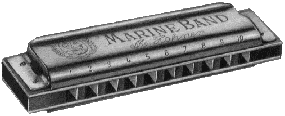

.
Harmonica Licks
.![]()
.
![]() Harp-L
- Bulletin Board and Archives
Harp-L
- Bulletin Board and Archives
![]() Society
for Preservation and Advancement of the Harmonica
Society
for Preservation and Advancement of the Harmonica
.
![]()
.
![]() Hear
a Doppler Shifted Tone (Listen as the pitch rises and falls with intensity.)
Hear
a Doppler Shifted Tone (Listen as the pitch rises and falls with intensity.)
Shifts in pitch can be heard when listening to natural sources that result in a relatively constant observed frequency, but that sweep up and down in intensity. One example is the pitch change that occurs with the movement of passing insects like mosquitos. The motion is slow enough so that virtually no Doppler shift in frequency occurs, yet the change in intensity can produce a pitch change.
![]() Hear
a Swarm of Mosquitos (Notice the pitch modulations.)
Hear
a Swarm of Mosquitos (Notice the pitch modulations.)
In general, when ever a mosquito or other insect flies by your ear, any change in pitch that you experience is due to the dynamic intensity change, and is an example of the Doppler illusion.
.
![]()
.
Catching an Approaching Ball
Two Major cues used to judge approach of a ball:
2. Rate of change in optical size.

|
|
|
[Last updated September 9, 1997: by M. K. McBeath]